Historical Decline in Interest: Why Institutional Investors Are Turning Away from the "Magnificent Seven" Stocks
Hedge Fund Positions at Their Lowest in History
Institutional investors are displaying unprecedented low interest in the stocks of technology giants known as the "Magnificent Seven" (Apple, Microsoft, Alphabet (Google), Amazon, Nvidia, Meta, and Tesla). The ratio of long to short positions held by hedge funds in these seven stocks has fallen to approximately 2.5x – a record low, compared to around 3.0x at the end of the bear market in 2022. This suggests that there are now only 2.5 short positions for every long position, reflecting a sharp decline in optimism. Concurrently, the net long exposure of hedge funds to the "seven" has decreased by approximately 8 percentage points over the past year, falling to around 13%, close to a two-year low, indicating a decline in growth expectations. This caution among institutional investors towards the largest tech companies is historically unique and is already affecting market dynamics and current sentiment.
Notably, this comes despite a partial recovery in technology sector valuations recently. Stocks of the "Magnificent Seven" are still trading, on average, about 18-20% below their peak levels from December, even after recent increases. In contrast, Bloomberg's collective Magnificent 7 index had dropped more than 20% from its December peak by mid-March 2025. Thus, part of the losses from late 2024 remains unrecouped, reinforcing the caution among hedge funds. This reduction in institutional interest starkly contrasts with the previously observed enthusiasm surrounding these stocks and prompts a reconsideration of fundamental factors and technical signals.
Fundamental and Technical Factors: Analyzing Each of the Seven Stocks
Below is a fundamental analysis of key indicators and events for each company, as well as a technical analysis of price charts, highlighting RSI, MACD, support and resistance levels. This comprehensive overview allows us to understand why, despite varying financial outcomes among all seven firms, a similar caution persists among major investors.
Apple (AAPL): Resilient Finances, Seeking New Growth Drivers
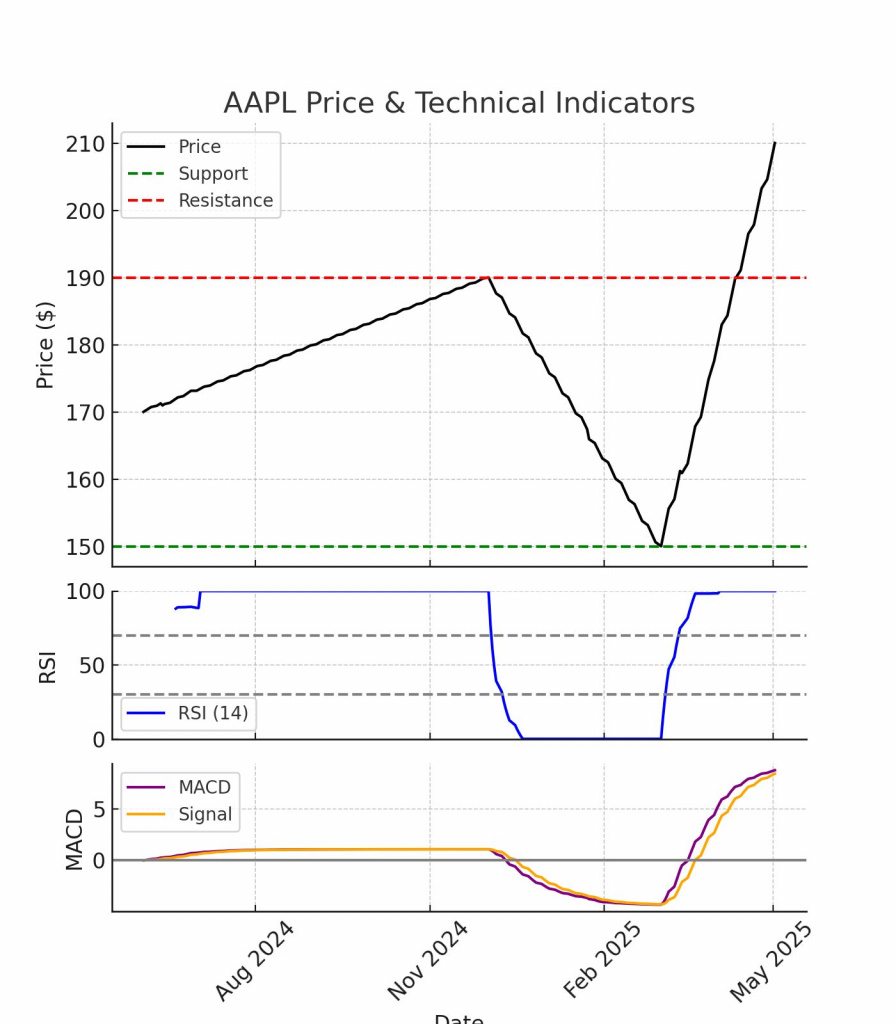 Technical Analysis of Apple (AAPL): Shares of Apple exhibited volatility in 2025. The chart reveals that after rising to approximately $190 (a resistance level) at the end of 2024, the price retreated to support around $150, then skyrocketed past previous highs. The RSI remained in the neutral zone for an extended period but fell below 30 (oversold) during a sharp decline, signaling a localized exhaustion of selling. By May 2025, the RSI returned to the 60 area, reflecting a resurgence in demand. The MACD confirmed a shift in sentiment: at the start of 2025, the indicator dipped into the negative zone, indicating a bearish trend, but a bullish reversal occurred in spring as the MACD line rose above the signal line, indicating an acceleration in upward momentum.
Technical Analysis of Apple (AAPL): Shares of Apple exhibited volatility in 2025. The chart reveals that after rising to approximately $190 (a resistance level) at the end of 2024, the price retreated to support around $150, then skyrocketed past previous highs. The RSI remained in the neutral zone for an extended period but fell below 30 (oversold) during a sharp decline, signaling a localized exhaustion of selling. By May 2025, the RSI returned to the 60 area, reflecting a resurgence in demand. The MACD confirmed a shift in sentiment: at the start of 2025, the indicator dipped into the negative zone, indicating a bearish trend, but a bullish reversal occurred in spring as the MACD line rose above the signal line, indicating an acceleration in upward momentum.
From a fundamental perspective, Apple remains a relatively stable "safe haven." The latest quarterly report showed $95.4 billion in revenue and EPS of $1.65, slightly exceeding forecasts. The core business (iPhone, services) generates stable cash flows; however, growth rates have slowed. Management points to uncertainty surrounding tariffs and supply chains, complicating forecasts for the second half of the year. In this context, hedge funds apparently do not anticipate breakthrough growth from Apple in the near future. Nonetheless, the company is investing in new directions (e.g., augmented reality devices), and a substantial cash reserve and buybacks support the fundamental attractiveness of the stock. Institutional investors valued Apple more highly than others – notably, its shares reached an all-time high in 2025 – yet even here positions were reduced due to the overall overheating of the tech sector.
Microsoft (MSFT): Cloud Leader Reaches New Heights
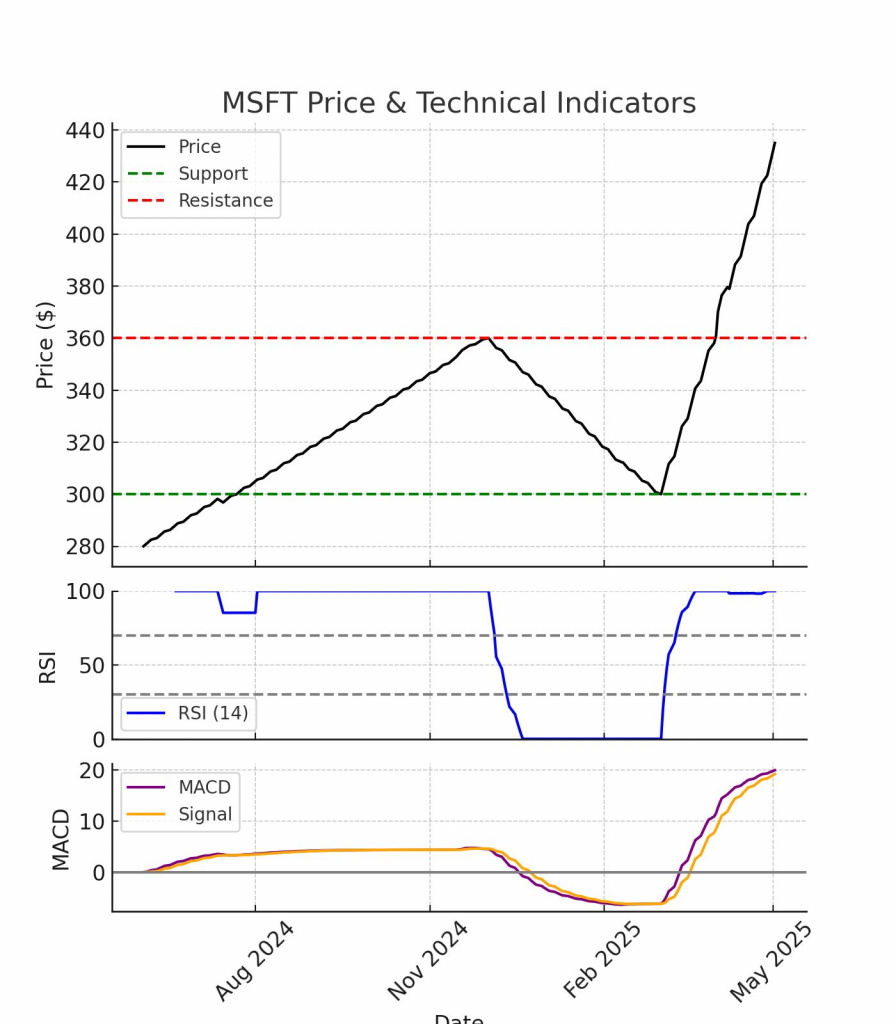
Fundamentally, Microsoft justifies investor interest with vigorous growth in its cloud and AI division. In Q1 2025, Azure once again surprised – Microsoft's cloud revenue exceeded expectations, while its closest competitor, AWS, slowed down. The company's total revenue and profit are breaking records, driven by both cloud services and software (Office, Windows), along with investments in OpenAI and AI services. According to Reuters, Azure's cloud business has significantly accelerated and exceeded forecasts, bolstering optimism surrounding Microsoft. Given these metrics, MSFT shares reached new all-time highs in 2025. However, institutional investors maintain caution due to the high valuation (Microsoft's P/E is at multi-year highs) and the overall concentration of capital among a few tech giants. Nonetheless, fundamentally, Microsoft remains one of the most solid and rapidly growing representatives of the “seven,” which mitigates the pessimism. Hedge funds have reduced their MSFT holdings, but not as aggressively as with other companies.
Alphabet/Google (GOOGL): Stable Business Under Competitive Pressure
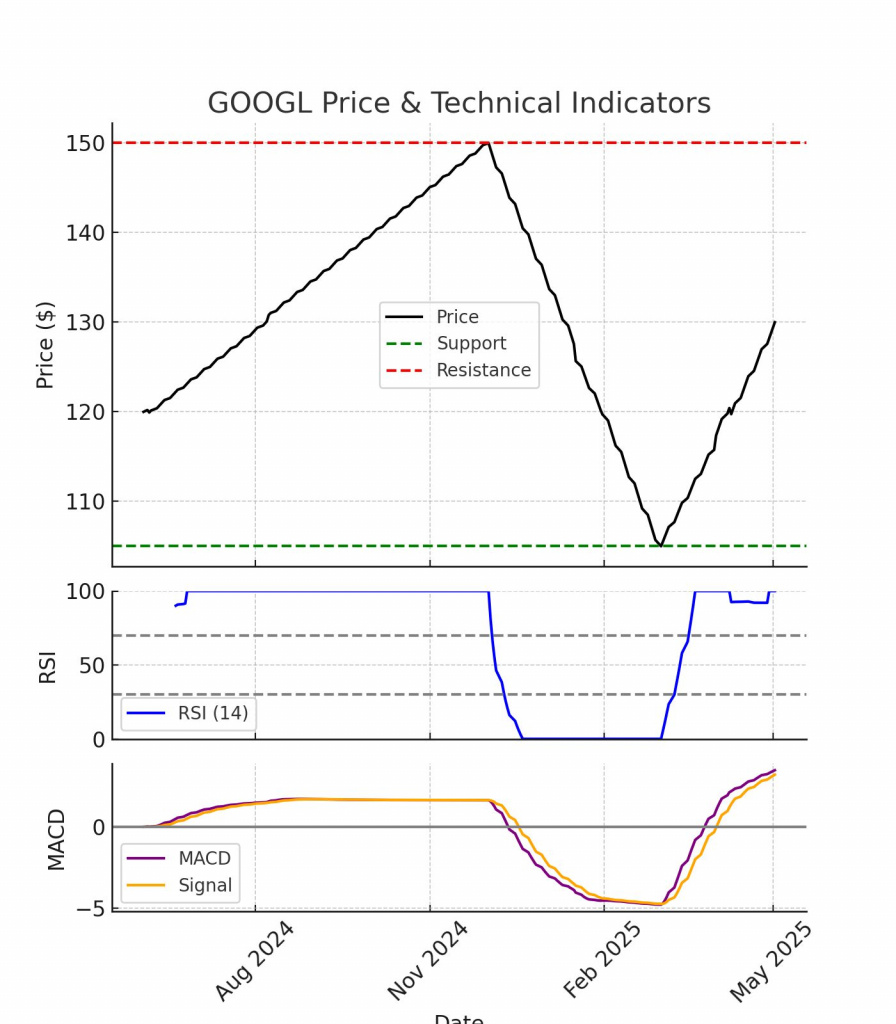 Technical Analysis of Alphabet (GOOGL): Alphabet shares faced volatility – from summer 2024 to winter 2025, their trajectory resembled a "hump." The price rose to about $150 by the end of the previous year, then sharply fell to approximately $105 in early 2025 (a support level), before bouncing back to around $130. The RSI during the crash dipped below 30, indicating oversold conditions for Google shares for the first time in a long while. This coincided with market pessimism regarding the advertising business's outlook and costs related to AI. In April 2025, the RSI returned to the 50-60 range, reflecting a neutral sentiment – investors remain uncertain about a new rally. The MACD lingered in the negative area for an extended period, confirming the bearish trend during winter; only in spring did the MACD lines begin converging toward zero. As of now, there is no clear bullish signal from the MACD, indicating a restraint in growth momentum.
Technical Analysis of Alphabet (GOOGL): Alphabet shares faced volatility – from summer 2024 to winter 2025, their trajectory resembled a "hump." The price rose to about $150 by the end of the previous year, then sharply fell to approximately $105 in early 2025 (a support level), before bouncing back to around $130. The RSI during the crash dipped below 30, indicating oversold conditions for Google shares for the first time in a long while. This coincided with market pessimism regarding the advertising business's outlook and costs related to AI. In April 2025, the RSI returned to the 50-60 range, reflecting a neutral sentiment – investors remain uncertain about a new rally. The MACD lingered in the negative area for an extended period, confirming the bearish trend during winter; only in spring did the MACD lines begin converging toward zero. As of now, there is no clear bullish signal from the MACD, indicating a restraint in growth momentum.
Fundamentally, Google remains the advertising giant, but it faces new challenges. Advertising revenues stabilized after a downfall in 2022, and in 2024-2025, the company is once again showing revenue growth from advertising thanks to YouTube and search. However, competition in AI and search technologies has intensified – the emergence of ChatGPT and other AI tools has compelled Alphabet to invest heavily in developing Google Bard and cloud AI services. These investments are weighing on margins: operational expenses have risen, and profitability is decreasing. Nevertheless, recent results exceeded expectations: net income in Q1 2025 increased, and Google Cloud achieved operational profit for the first time last year, instilling optimism. Institutional investors are currently taking a wait-and-see position: although GOOGL shares are relatively inexpensive (with a P/E lower than many "peers"), uncertainty surrounding AI's impact on the search business is restraining major funds from increasing their stakes. Hedge funds substantially reduced long positions in Google, anticipating clarity on the company’s strategy and its ability to maintain dominance.
Amazon (AMZN): Slowdown in Cloud and Cost Pressures
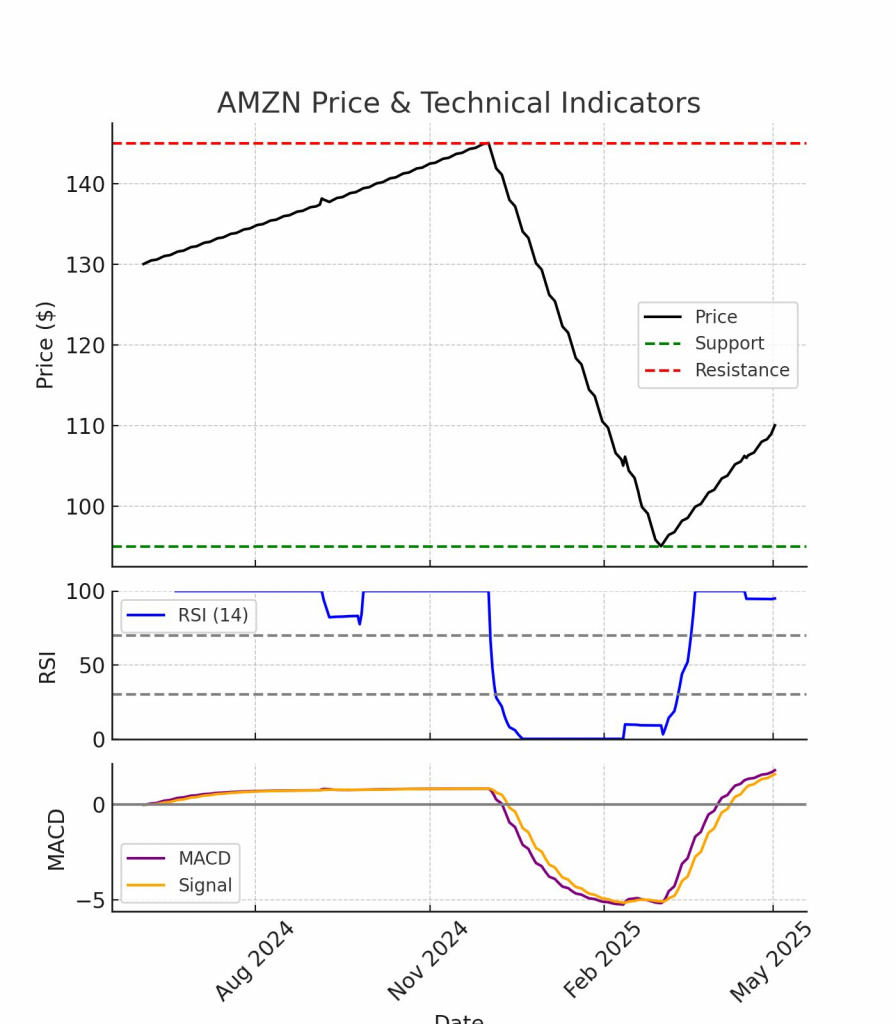 Technical Analysis of Amazon (AMZN): Amazon shares continued to feel pressure. The chart illustrates a gradual increase in quotes during the second half of 2024 to around $145, followed by a sharp downward trend – by early 2025, the securities plummeted to approximately $95 (minimum with support). The RSI indicated persistent oversold conditions during this decline – the indicator dropped significantly below 30 and remained there for an extended period. This reflects a strong negative market sentiment towards Amazon. In spring 2025, the RSI rose to around 50, though it did not exceed 60, indicating that there is still no definite upward momentum. The MACD line also remained below zero: for a long time (from late 2024 to March 2025), the MACD displayed negative dynamics, and only by April did it begin to rise toward the 0 mark, suggesting a weakening of bearish pressure, but not a clear upward turnaround.
Technical Analysis of Amazon (AMZN): Amazon shares continued to feel pressure. The chart illustrates a gradual increase in quotes during the second half of 2024 to around $145, followed by a sharp downward trend – by early 2025, the securities plummeted to approximately $95 (minimum with support). The RSI indicated persistent oversold conditions during this decline – the indicator dropped significantly below 30 and remained there for an extended period. This reflects a strong negative market sentiment towards Amazon. In spring 2025, the RSI rose to around 50, though it did not exceed 60, indicating that there is still no definite upward momentum. The MACD line also remained below zero: for a long time (from late 2024 to March 2025), the MACD displayed negative dynamics, and only by April did it begin to rise toward the 0 mark, suggesting a weakening of bearish pressure, but not a clear upward turnaround.
Fundamentally, Amazon is going through a mixed period. On one hand, the primary retail division has faced market saturation and a slowdown in online shopping growth; Amazon has had to optimize costs, reduce staff, and warehouses. On the other hand, its key profit driver – the AWS cloud – is showing decreasing growth rates. In Q1 2025, AWS revenue grew by only +16.9% year over year, the lowest growth in five quarters and below analyst expectations. This underperformance is particularly noticeable against the backdrop of Azure's success at Microsoft. Calculations indicate that the high-margin AWS business is facing competition and client caution amid economic uncertainty. At the same time, Amazon's operating profit came under pressure: forecasts for operating income for Q2 were lowered, disappointing investors. Consequently, AMZN shares in 2025 fell harder than most of the "seven," and hedge funds significantly reduced their net long position. However, Amazon also has positive aspects: the rapidly growing advertising segment (+19% in 2024) and efforts to expand service offerings (streaming, fintech). Institutional investors are likely to return to Amazon upon seeing signs of accelerating AWS growth or improving retail margins, but for now, they remain cautious.
Nvidia (NVDA): AI Hype and High Volatility
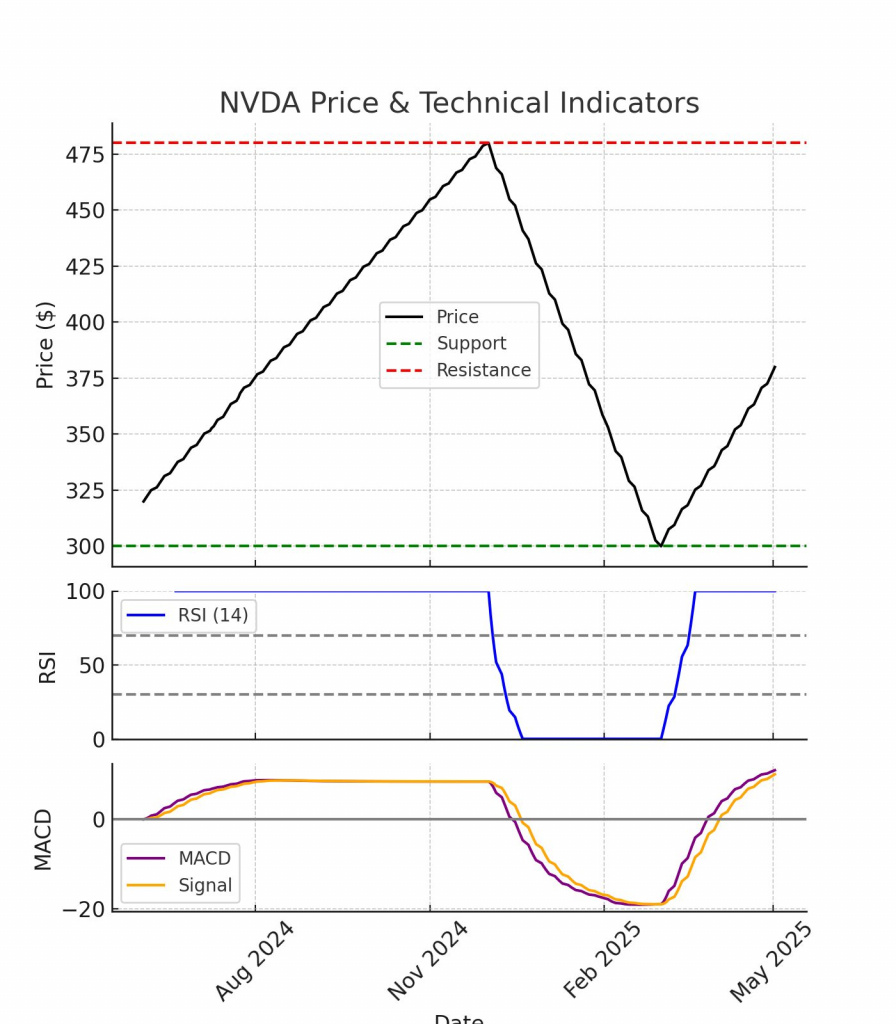 Technical Analysis of Nvidia (NVDA): The NVDA chart illustrates extreme fluctuations. By the end of 2024, shares soared to about $480 on the wave of AI euphoria (a resistance level), followed by a correction – by early 2025, the price fell to about $300. This level became a key support from which quotes bounced back in spring to around $380. The RSI for Nvidia at the peak of growth reached the overbought zone (above 70) – investors were actively buying shares in anticipation of record profits from AI chips. Then, the RSI plummeted below 30 during a harsh sell-off in winter, indicating severe oversold conditions. By May 2025, the RSI returned to the neutral range (approximately 50-55), reflecting a balance of optimism and doubts. The MACD has also shown swift reversals: after an outstanding bullish trend in 2024, the MACD line crossed the signal line downward in early 2025, warning of the onset of a bearish phase. However, by spring, the MACD began to recover – the indicator's rise toward zero signals the end of the downward phase, although no clear upward crossover has yet occurred.
Technical Analysis of Nvidia (NVDA): The NVDA chart illustrates extreme fluctuations. By the end of 2024, shares soared to about $480 on the wave of AI euphoria (a resistance level), followed by a correction – by early 2025, the price fell to about $300. This level became a key support from which quotes bounced back in spring to around $380. The RSI for Nvidia at the peak of growth reached the overbought zone (above 70) – investors were actively buying shares in anticipation of record profits from AI chips. Then, the RSI plummeted below 30 during a harsh sell-off in winter, indicating severe oversold conditions. By May 2025, the RSI returned to the neutral range (approximately 50-55), reflecting a balance of optimism and doubts. The MACD has also shown swift reversals: after an outstanding bullish trend in 2024, the MACD line crossed the signal line downward in early 2025, warning of the onset of a bearish phase. However, by spring, the MACD began to recover – the indicator's rise toward zero signals the end of the downward phase, although no clear upward crossover has yet occurred.
Fundamentally, Nvidia has become a symbol of the AI boom: demand for its GPUs for training neural networks has skyrocketed. Throughout the 2024 fiscal year, Nvidia repeatedly reported record quarterly revenues, significantly exceeding Wall Street forecasts. At the end of 2024, the data center segment (Nvidia's core AI chip segment) generated over $3.8 billion in profit – an unprecedented result. However, such rapid growth occurred over a short period, and investors have begun to fear overheating. The stock's valuation reached extremely high levels (P/E >> 50), making the shares vulnerable to even the slightest disappointment. Additionally, geopolitical risks (chip export restrictions to China) and limited production capacity add uncertainty. Hedge funds likely locked in profits after the grand rally of 2023, resulting in record low net longs on NVDA. Nevertheless, Nvidia remains fundamentally strong: it is practically a monopolist in the high-performance AI accelerator segment, with margins exceeding 60%. Institutional investors may return when volatility subsides – for now, they prefer caution, remembering the lessons of the 2000 bubble. As a result, Nvidia is the paradox of the "seven": excellent finances coexist with fund caution due to the asset's expensiveness.
Meta (META): Returning to Growth and Overcoming Trust Issues
 Technical Analysis of Meta (META): Meta Platforms shares, the parent company of Facebook, Instagram, and WhatsApp, have undergone a sharp decline and recovery. Following a rise to approximately $330 (December peak of 2024), the shares plummeted to about $230 in early 2025 (a strong support area coinciding with late 2022 levels). The RSI for Meta sank into the ~25-30 range during the decline, indicating oversold conditions – investors reacted panically to potential slowdowns in advertising and expenses related to the metaverse. However, by spring, the RSI returned to the 50+ zone, reflecting improved sentiment as shares rose to around $280. The MACD confirms this turnaround: after a prolonged negative trend in fall-winter 2024/25 (MACD < 0), the MACD line confidently crossed the signal line from below in spring, approaching zero – a sign of a gradual recovery in bullish momentum.
Technical Analysis of Meta (META): Meta Platforms shares, the parent company of Facebook, Instagram, and WhatsApp, have undergone a sharp decline and recovery. Following a rise to approximately $330 (December peak of 2024), the shares plummeted to about $230 in early 2025 (a strong support area coinciding with late 2022 levels). The RSI for Meta sank into the ~25-30 range during the decline, indicating oversold conditions – investors reacted panically to potential slowdowns in advertising and expenses related to the metaverse. However, by spring, the RSI returned to the 50+ zone, reflecting improved sentiment as shares rose to around $280. The MACD confirms this turnaround: after a prolonged negative trend in fall-winter 2024/25 (MACD < 0), the MACD line confidently crossed the signal line from below in spring, approaching zero – a sign of a gradual recovery in bullish momentum.
Fundamentally, Meta made a dramatic turnaround in 2023-2025. Following a shocking drop in earnings and share prices in 2022 due to budget cuts in advertising and massive losses at Reality Labs, the company embarked on an "efficiency year". CEO Mark Zuckerberg laid off thousands of employees, cut costs, and refocused the strategy on AI projects. Results soon followed: in Q1 2025, Meta’s revenue grew 16% year over year, reaching $42.3 billion, while net income soared by 34.6%. The operating margin recovered from 25% to 41% due to cost reductions and rising advertising sales. The advertising business (≈98% of revenues) is thriving again – both users and advertisers have returned. Meanwhile, the Reality Labs division remains loss-making ($4.2 billion loss for the quarter), but this factor is already priced in by the market. Thus, Meta currently combines strong fundamental metrics (revenue growth, high profitability) with previous risks (large expenses on the metaverse and regulation). Institutions have taken note of the positives: against the backdrop of excellent reports, META shares were among the few in the "seven" to show growth in early 2025. However, the overall market downturn still dragged Meta into the negative YTD zone by March. Hedge funds have reduced their net long position in Meta, although less aggressively than with others: growth prospects exist, but overall pessimism and memories of last year's failures compel them to act cautiously.
Tesla (TSLA): Sales Growth at the Cost of Margin and Trust
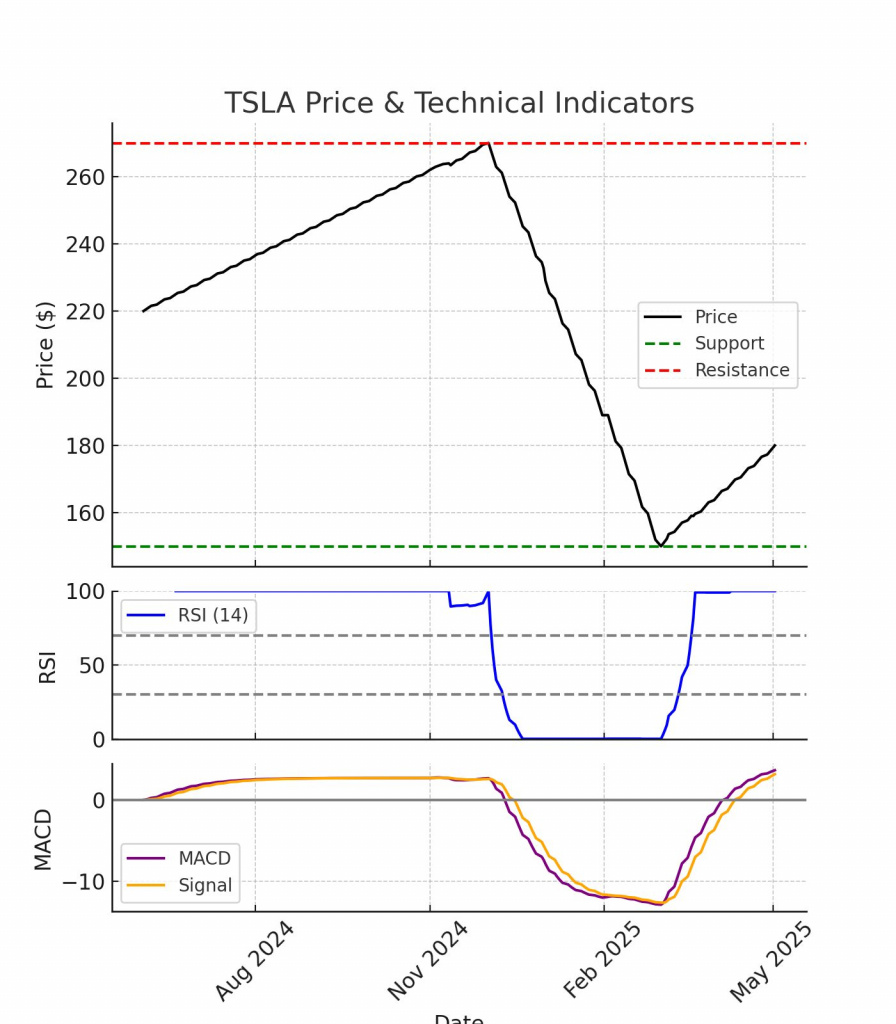 Technical Analysis of Tesla (TSLA): Tesla’s shares are traditionally the most volatile among the "seven." After rising in summer-autumn 2024 to approximately $270 (local resistance), the stock plummeted to around $150 by early 2025 – over 40% loss in value in a few months. The RSI remained deeply below 30 for an extended period, indicating extreme oversold conditions as the market priced in negative expectations for electric vehicle demand. By April-May 2025, the RSI rose only to ~50, signaling a slow recovery of investor confidence. The MACD has been below zero since late 2024, indicating a bearish phase; only by April 2025 did the MACD line begin to cross the signal upward, hinting at a weakening of the downward trend. However, technically, Tesla is yet to demonstrate a clear bullish reversal – the resistance around $260 remains relevant, while support at $150 has been tested.
Technical Analysis of Tesla (TSLA): Tesla’s shares are traditionally the most volatile among the "seven." After rising in summer-autumn 2024 to approximately $270 (local resistance), the stock plummeted to around $150 by early 2025 – over 40% loss in value in a few months. The RSI remained deeply below 30 for an extended period, indicating extreme oversold conditions as the market priced in negative expectations for electric vehicle demand. By April-May 2025, the RSI rose only to ~50, signaling a slow recovery of investor confidence. The MACD has been below zero since late 2024, indicating a bearish phase; only by April 2025 did the MACD line begin to cross the signal upward, hinting at a weakening of the downward trend. However, technically, Tesla is yet to demonstrate a clear bullish reversal – the resistance around $260 remains relevant, while support at $150 has been tested.
Fundamentally, Tesla is facing contradictions. On the one hand, electric vehicle sales continue to grow, and the company maintains its market leadership in EVs. Management aims to deliver about 1.8 million vehicles in 2025, expanding production capacity. Moreover, Tesla is preparing to roll out a more affordable model and is developing robotaxi technologies. On the other hand, to stimulate demand in the face of an economic downturn and increased competition (especially from Chinese automakers), Tesla has resorted to significant discounts and price reductions on its models. This has negatively impacted margins: the company’s automotive gross margin fell to 12.5% in Q1 2025 (excluding regulatory credits), down from approximately 19% a year earlier, and net income plummeted by 71%. While cost-cutting helped exceed margin expectations in Q1, revenue from auto sales dropped by 20%, disappointing Wall Street. Investors fear that the price war may continue, eating into profits. Elon Musk acknowledges the influence of macro factors: according to him, economic uncertainty is causing consumers to delay expensive purchases (i.e., vehicles). All this has undermined the previous enthusiasm towards TSLA shares. Hedge funds have significantly reduced positions – Tesla shares were among the poorest performers in early 2025. Institutional investors are waiting for clarity on demand dynamics and the emergence of a new "trigger" (such as the launch of a budget model or improved margins) before returning. Nonetheless, Tesla retains long-term potential due to its innovations and strong brand, which could attract funds back when market conditions improve.
Parallels with Past Periods of Pessimism (2000 and 2008)
The current situation recalls well-known phases of extreme negativity in the market. During the dot-com crash from 2000 to 2002, the technology-focused Nasdaq Composite plummeted by 78% from its peak – investors were wholly disenchanted with the prospects of even the largest companies. Similarly, at the height of the global financial crisis in 2008-2009, the broad market had to endure a decline of nearly 60% (the S&P 500 fell by 57% from its peak) before confidence began to return. Certainly, the current -18% from the peaks is far less dramatic; however, the behavior of institutional investors is similar: hedge funds are sharply reducing risks, lowering leverage and "waiting for better days." Even the “Magnificent 7,” once growth locomotives, are now met with caution – their high concentration in indices recalls the vulnerability of the dot-com bubble, and global risks (such as Fed rates, geopolitics, recession) draw parallels with 2008.
An important lesson from 2000 and 2008 is that periods of extreme pessimism create the groundwork for subsequent rallies. When all bad news is reflected in prices and investors go short en masse, the market often finds a bottom. The current record-long/short ratio of 2.5x suggests that bearish sentiment has already reached historical peaks. Perhaps “smart money” anticipates further declines, but such low exposure may indicate limited scope for additional sell-offs. If the macroeconomic picture improves or the "Magnificent Seven" companies show unexpected successes (e.g., new products or sharply rising metrics), the influx of money back into these stocks could be swift.
Conclusion: A Look Ahead
The current historical decline in institutional interest in the “Magnificent Seven” stocks is driven by a combination of factors: high valuations and concentration of risks, slowing growth (in the cloud at Amazon and advertising at Google), declining profitability (Tesla), and overall market risk-off sentiment. Hedge funds have driven net exposure to record lows, effectively expressing distrust in the further explosive growth of tech giants in the short term. This is largely a technical reaction – a desire to lock-in profits after years of rallies – but also a fundamental reassessment of prospects. Nevertheless, fundamental analysis reveals that many of these companies remain financially healthy and adaptable: Microsoft and Meta are beating profit forecasts, Apple and Google generate stable cash flows, and Nvidia leads the new technological cycle of AI. As soon as the current market sentiment shifts to a more optimistic tone, institutional investors may begin to return to these stocks, seeking not to miss a new growth phase.
For now, a cautious approach prevails. The market is closely monitoring economic data and reports: if inflation and rates decline and corporate results improve, a recovery of confidence is likely. Otherwise, the stocks of the “seven” may continue to stagnate or decline until their valuations become attractive enough even for the most skeptical hedge funds. In any case, the current situation represents a sort of regrouping of power in the market. Institutional investors and hedge funds have temporarily stepped back from tech giants, but it would not be wise to write off the "Magnificent Seven." History shows that it is in moments of utmost pessimism that the best long-term opportunities arise. Today’s decline in interest could lead to a new surge when the fundamental values of these companies come back to the forefront, and technical analysis signals a trend reversal. The key is to monitor essential indicators and remain vigilant in anticipation of a shift in market sentiment.




